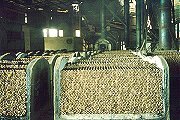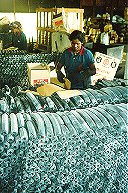

Malaysia 
 |
Wood Energy Situation Policies and Programmes Wood Energy Data Further Reading RWEDP Focal Points |
Wood Energy Situation
Wood energy accounts for 9% of total energy consumption in Malaysia. Statistics show that most biomass energy is consumed by industries, but data on woodfuel use by households are not available. In the domestic sector biomass energy is mainly used for cooking.
Malaysia is exceptional among RWEDP-member countries for several reasons. It has the highest GDP per capita, it has severe (unskilled) labour shortages, and it has a policy of increasing its population. Furthermore, Malaysia has adequate energy sources, e.g. oil for another 16 years and gas for another 60 years at the controlled present consumption levels. New exploration is being successfully undertaken. The country is also relatively well off in wood and biomass resources, and no severe fuel shortages are reported. This is not withstanding the fact that rubber wood is now much less available as most of it is now being used in the furniture industry.
Policies and Programmes
Malaysia has been welcomed as a new member in the present phase of RWEDP. The delegation from the Prime Minister's Department Energy Planning Unit (EPU) quickly took up the challenge of wood/biomass energy planning, which was not practised in Malaysia. EPU is already incorporating wood energy into the forthcoming five-year development plan and into a prospective energy plan, thus taking a lead among RWEDP-member countries. The EPU is determined to collect data on a regular basis. A national committee for renewable energy is being established, with a sub-committee on biomass energy.
 The forestry sector and/or the Forest Research Institute of Malaysia (FRIM) is being asked to join the committee. One of the objectives is to utilise wood and biomass waste more efficiently as an energy source, for environmental and economic reasons. At FRIM, a lot of expertise on wood energy resource use and conversion has already been acquired due to its ongoing and active research programmes. This includes modern technologies for briquetting, conversions, cogeneration and residue utilisation.
The forestry sector and/or the Forest Research Institute of Malaysia (FRIM) is being asked to join the committee. One of the objectives is to utilise wood and biomass waste more efficiently as an energy source, for environmental and economic reasons. At FRIM, a lot of expertise on wood energy resource use and conversion has already been acquired due to its ongoing and active research programmes. This includes modern technologies for briquetting, conversions, cogeneration and residue utilisation.
With regard to a wider range of fuels from biomass, research results from the Palm Oil Research Institute of Malaysia on carotene from palm oil are interesting. It is reported that the marketing of two palm oil products together, i.e. carotene and palm oil-engine fuel, constitute a financially viable proposition. Tests are being carried out with this biofuel on public buses in Malaysia.
Wood Energy Data
| General | |||||
| Population (1996) | 20.6 mln. | ||||
| Share of Rural Population | 45.5% | ||||
| GDP per capita (1995) in constant 1987 US$ | 3,098 | ||||
| Energy Consumption (1995) | |||||
| Total Final Energy Consumption in PJ | 1,048.1 | ||||
| Consumption of Wood Energy in PJ | 99.5 | (9.5%) | |||
| Consumption of Biomass Energy in PJ | 135.1 | (12.9%) | |||
| Wood Energy Resources | |||||
| Forest Area (1995) in 1000 ha | 15,417 | (47.1%) | |||
| Natural Forest Area (1995) in 1000 ha | 15,371 | (46.8%) | |||
| Agricultural Area (1994) in 1000 ha | 7,885 | (24.0%) | |||
| Share of Woodfuels from Forest Areas | NA | ||||
| Potential Wood Energy Supply (1994) | |||||
| Sust. Supply from Natural Forest in kton | 31,321 | ||||
| Sust. Supply from Forest Plantations in kton | 416 | ||||
| Sust. Supply from Agriculture Areas in kton | 17,809 | ||||
| Supply from Wood Waste from Deforestation in kton | 87,754 | ||||
| Total Potential Supply in kton | 137,301 | ||||
| Primary Wood Energy Requirements in kton | 6,187 | ||||
Notes:
Population and land use data from FAO (FAOSTAT), GDP per capita from World Bank. Energy consumption data from various sources.
Potential wood energy supply estimated by RWEDP, based on available data for land use, wood productivity and estimates on availability of wood for energy use. For forest land, other wooded land and agriculture areas, the potential supply is based on average annual yield estimates, assuming a sustainable use of resources (Sust.: sustainable). Wood waste from deforestation refers to wood potentially available from natural forest land cleared due to commercial logging, expansion of agriculture land or other reasons. The estimates are based on aggregated national data, which can hide local variations, ranging from scarcity to abundance. For detailed calculations and estimates for 2010, see FD50, chapter 8
Further reading:
| Regional Study on Wood Energy Today and Tomorrow in Asia, Field Document 50, 1997 | |
| Chapter 8 in Review of Wood Energy Data in RWEDP Member Countries, Field Document 47, 1997 | |
| Biomass Energy in Asean Member Countries, 1997 |
RWEDP Focal Points in Malaysia
Focal points are the main contacts for RWEDP in a member country. Generally, in each country, there is one focal point in the energy sector, and one in the forestry sector.
| Director General Forest Research Institute Malaysia Kepong Selangor Kuala Lumpur 52109 TEL: 60-3-6342633 FAX: 60-3-6367753 | Director General Economic Planning Unit Prime Minister's Department Jalan, Dato'Onn Kuala Lumpur TEL: 60-3-2300133 FAX: 60-3-2914268 |
Comments, questions? webmaster@rwedp.org
© FAO-RWEDP, 1999